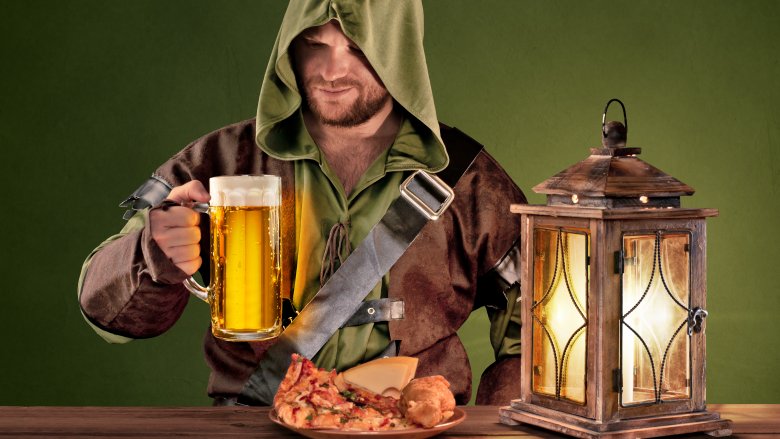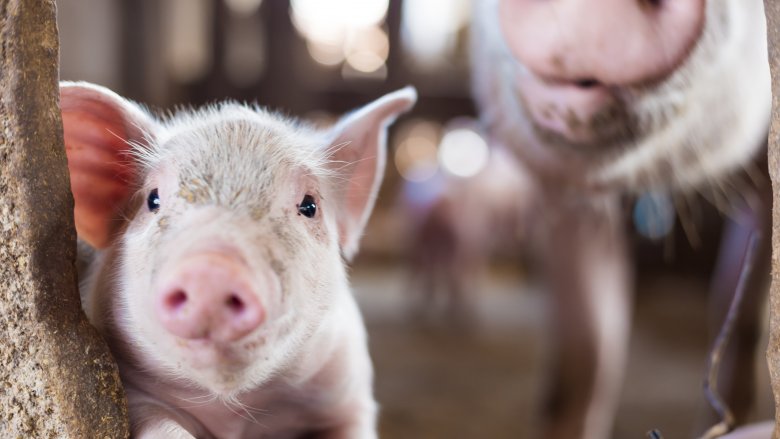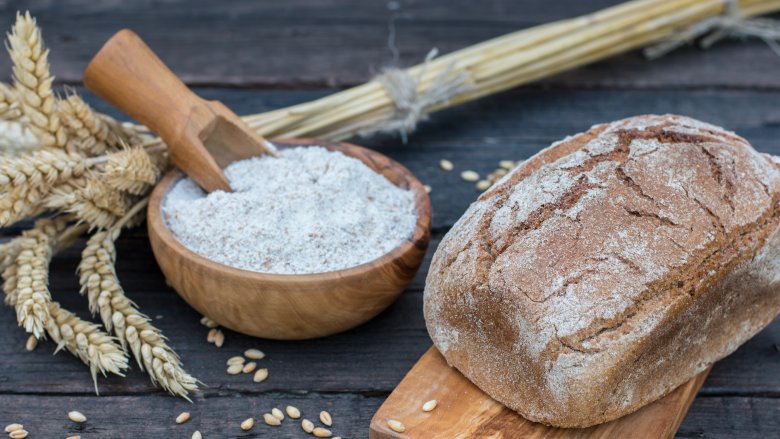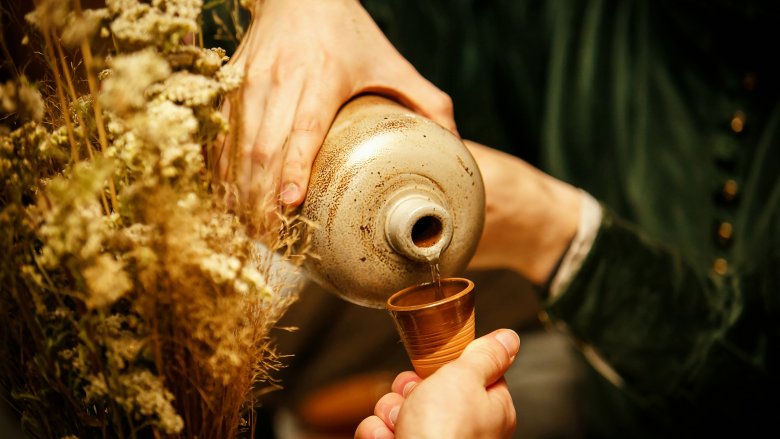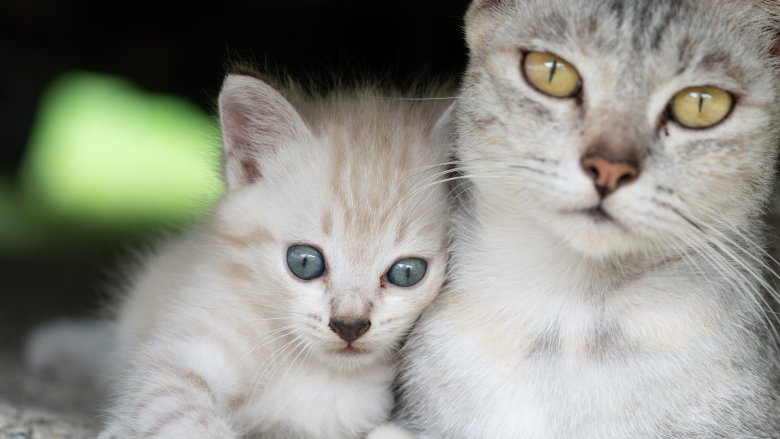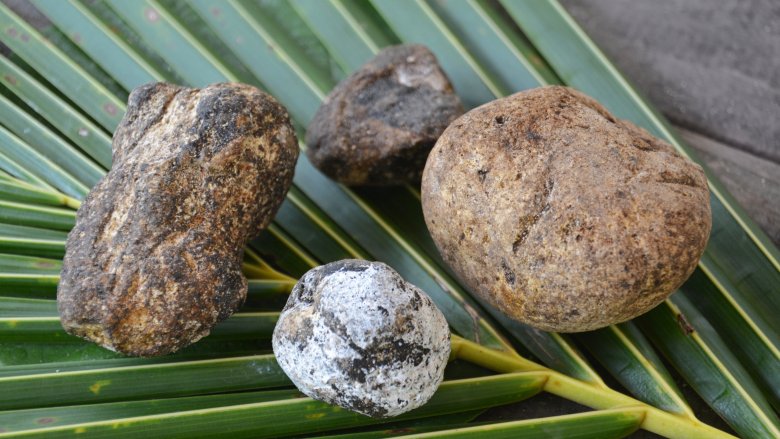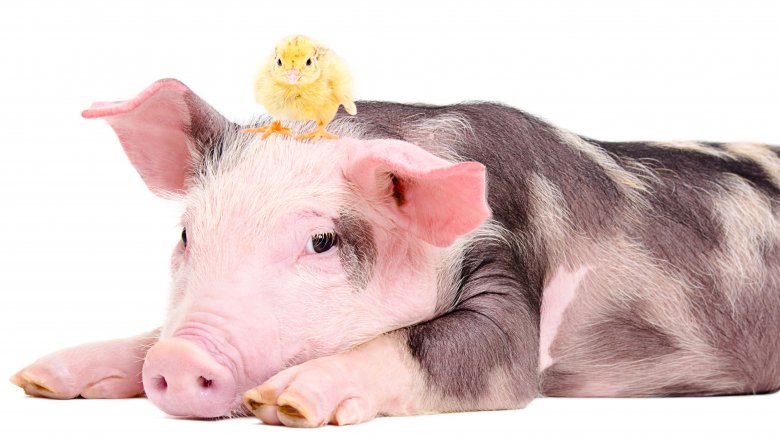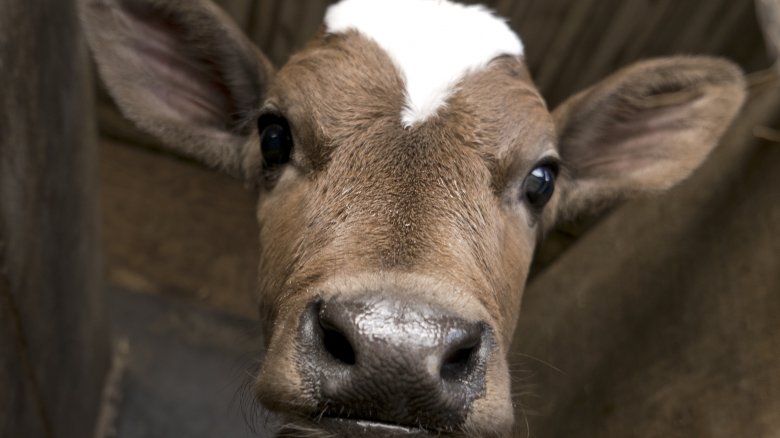Unusual Foods People Used To Eat
Take a peek at Instagram on any given day, and you'll find it's full of delicious creations and quite a few strange ones. Modern-day chefs and culinary artists are always looking to put their own spin on things, whether it's glitter coffee or making the biggest, baddest freakshake you can imagine.
Food trends are a way of life now, and some of them get pretty strange. But even today's weirdest food trends have nothing on the strange things people used to eat. From blood soup, to cute critters, and everything in between, the diets of yesterday would be hard to stomach today.
We're looking as far back as Ancient Rome, and as recently as the Depression-era to uncover the oddest foods to grace their dinner tables. One glance at this list, and you'll thank your lucky stars for the McDonald's down the street.
Mice
Dormice were a major menu item in ancient Rome back to the first century BC, and they were such a big deal, says Atlas Obscura, that archaeological evidence has been found to suggest farmers raised dormice to sell to the upper classes. Raising them wasn't as simple as you might think, either. Special clay jars called glirariums were used to house the dormice, who would live in near-darkness and eat acorns and chestnuts in their little, artificial burrow. Once they were chunky enough, they would be cooked and served, usually with honey and poppy seeds, stuffed with another meat, or roasted in a casserole.
The bigger and fatter the dormouse, the better they were. Some of the most extravagant Roman feasts would employ scribes to record the weight of the animals served, and there was a reasoning behind this. If you were rich enough to devote some serious time, effort, and money to raising (or buying) the fattest dormice, you were pretty well off. The largest estates had entire areas devoted to raising the adorable little critters, and it's no wonder: ancient food writers always mentioned the quality of the dormice.
Poison pancakes
Pancakes and waffles are definitely delicious, and they're still a favorite in countless homes today. But starting somewhere around the 16th century, English diners were eating a different sort of pancake than what we're used to — and there was a huge problem with them. Their pancakes were called tansies, and they were made from a batter of eggs, vinegar, and liquid made from ground and crushed flowers that included the tansy, violets, feverfew, and herbs like parsley.
Atlas Obscura says most people served them during Lent and the Easter season, and there were a few things at work here. They were a welcome addition to the restrictive meals of Lent, and they were thought to have medicinal benefits like relieving digestive pains.
Tansies disappeared in the early 20th century, and now we know that far from being medicinal, the tansy flower is poisonous. According to the Government of Alberta, tansies produce alkaloids that are toxic to animals and people alike. So, for hundreds of years, people were eating poison pancakes.
Blood soup
Some civilizations were famous for their science, some for their culture, and some for their warriors. Sparta is one of the latter civilizations, and even centuries after their infamous soldiers waged war on neighboring city-states, we're still making movies about them.
What's often left out of those movies and their glorious training montages is a major part of the Spartan diet: melas zomos. That's the traditional black broth soup eaten by ancient Spartans, made from nothing more (or less) than boiled pig legs, vinegar, salt, and blood.
Our modern taste buds aren't the only ones cringing at the idea. Writer Pietros Maneossays (via The Huffington Post) says that even other ancient Greeks didn't like it. How much didn't they like it? When one visiting dignitary was treated to the dish he promptly spat it out and commented, "Now I know why you Spartans do not fear death."
Bulldog gravy (and a water sandwich)
The Great Depression was a dark time in American history, and it was one when families across the nation needed to get creative when it came to feeding their families. According to The Atlantic, there was an entire branch of the USDA — the Bureau of Home Economics — dedicated to helping people survive on the little food they had. There were plenty of beans, prunes, and mystery stews, but some of the foods were even more heartbreaking.
There are a few different versions of the song "I Am a Man of Constant Sorrow," made popular by O Brother, Where Art Thou? Some versions — including one called "I Am a Girl of Constant Sorrow" — makes mention of bulldog gravy. What is that? According to The Culinary Sleuth, it was a Depression-era Appalachian dish made from water, flour, and grease. It was usually served with a "water sandwich," which was nothing more than stale bread that had been soaked in a mix of lard and water. Even with that meager food, many families were forced to reduce their meals to an every-other-day schedule.
Cock-beer
If you think the craft beer movement has gone too far, just remember they don't have anything on the ingredients brewers and alewives used to use.
The blog British Food: A History stumbled across an 18th century recipe for cock-beer, and found it was definitely a real thing. Essentially it's a rooster, killed, gutted, and crushed, then left inside of vat of fermenting beer. Yum! They say that's a pretty tame version of the idea, and there's recipes that call for starting with a living, breathing rooster. Most cock-beer recipes go heavy on the spices, and that's likely because the addition of the chicken wasn't just for taste. The idea was that the rooster was imparting some of his traits — like vigour — to the brew, and anyone who drank it was going to be getting an extra dose of vitality.
It wasn't just roosters that were used, and in some places it was traditional to include blood from freshly slaughtered animals for the same reason. There are stories about the occasional human head being thrown in, too, and we can at least hope those are only stories.
Beaver tails and baby rabbits
What do beaver tails and baby rabbits have in common? They were once all seen as completely acceptable, "meat-free" meal options during Lent.
Let's start with beavers. Medieval reasoning said any animal who needed to take shelter on Noah's Ark for their survival was off-limits during Lent and other fasting days, but fish — who could fend for themselves during the flood — were fine to eat. That's great for people in coastal towns, but for inland cities? Not so much, says Atlas Obscura. That's where the Catholic Church stepped in. In the 17th century, the Bishop of Quebec started a movement that got the semi-aquatic beaver (and the capybara, another semi-aquatic mammal and the world's largest rodent) declared fishy enough to be an acceptable Lenten meal. (The capybara still is, in some parts of the world, says Scientific American.)
Bizarrely — and disturbingly — practicing Catholics in medieval Europe were allowed to eat unborn bunny babies during Lent, too. Suddenly, fish isn't looking so bad.
Roast cat
With apologies to cat-lovers everywhere... roast cat was on the menu in 16th century Spain.
Guidelines for cooking cat were found in a text simply called Book of Cooking (via the Society for Creative Anachronism), and it was a book about managing essentially middle-class households in Spain. Tucked between a recipe for garlic sauce for geese and meat casserole are directions for roast cat.
The cat should be a fat one, it says, and the head shouldn't be used because anyone who ate cat brains was likely to "lose his senses and judgment." After cleaning the cat, it was to be buried for a night and a day. The poor feline was then roasted on a spit, seasoned with garlic and oil, and whipped as it turned on the spit. They say it should be served like a rabbit or with broth, and "you may eat of it because it is very good food." We beg to differ.
Whale excrement
Ambergris has been a prized commodity for centuries, usually in perfume-making where it acts as a fixing agent to help the scent last longer. It comes from whales, and while it's not precisely whale poop, it is whale excrement of a sort. When whales eat squid and the beaks get stuck in their system, a fatty fluid buildup starts to congeal around the mass, which is eventually ejected, likely from the rear end of the whale — that's ambergris.
And people absolutely ate it, particularly in ancient Persia and India. The Manuscript Cookbooks Survey says it was often used as an additive, and after being such an integral part of medieval Arab culture it eventually spread to Europe and became popular in Italy and France first, then finally England.
It was a common ingredient in candies, pastries, whipped cream, puddings, cheesecakes, and even the occasional alcoholic beverage, adding a flavor described as "earthy" and "musky." If that wasn't bad enough, Atlas Obscura says ambergris was also used to make a 17th century ice cream some people described as "floral and mossy," and that others described as "barnyard and armpit."
Pig/turkey hybrids
We tend to think of "food as spectacle" as something that came with the age of Instagram and social media, but that's not the case. Food has been something of a social production for a long time, and between the 16th and 19th centuries, Europeans did a weird thing: they cut animals in half, sewed them back together, and presented them to diners as a sight to behold before eating.
One popular version was the cockentrice, which was essentially the front part of a pig sewn onto the back half of a turkey. The reverse — the front or top half of a turkey sewn onto the back end of a pig — was also done, and hey, at least nothing went to waste.
According to Hampton Palace food historian Richard Fitch (via The Atlantic), the dish dates back to the 15th century but remained popular for a good long time. Weird? Absolutely, and just is weird is another chicken-on-pig tradition called the Helmeted Cock. That's where chefs would dress a chicken in pseudo-shining-armor, then mount the cooked bird on a roast pig as though it were riding into battle. Why? It was the entertainment of the day.
Wax
Necessity is the mother of invention, and when it comes to finding ways to keep your family's bellies full when times are tight, people tend to get super creative. During World War II, people left behind on the home front struggled as resources were diverted to the war effort. Rationing meant cooks needed to find alternatives, and according to Cooks Info, so many people resorted to replacing cooking fat with paraffin wax that the British Ministry of Food needed to restrict it for medicinal purchases only — after all, it was a well-known laxative, so using it in your cooking had negative side effects for everyone at your table.
According to the BBC, liquid paraffin was substituted in a ton of dishes. Fried foods were no longer fried in oil, but in the melted, oil-based wax. It was also lumped into pastries and baked goods like the paraffin cake. The BBC's People's War archive of World War II memories include a recipe for paraffin cake, baked with flour, sugar, dried egg, baking powder, lemon essence, just enough milk to mix, and a few tablespoons of paraffin.
Crow
Crows can blanket entire fields, and if you've ever wondered why no one ever thought about eating them... they have.
In the 1930s, crow was on the menu in Tulsa, Oklahoma. Atlas Obscura says it was all thanks to one man: Dr. TW Stallings, who promoted crow as food because, well... he didn't really like crows, and encouraging people to eat the big black birds was one way he could cut down on their numbers. Farmers who fought a constant struggle against crows were quick to jump on board, and even Oklahoma's governor helped by founding the Statehouse Crow Meat Lovers Association.
Stalling recommended cooking them with lard and celery, then serving them with gravy. It took about three crows to fill the stomach of the average person, and before you judge, remember that this was the tail end of the Great Depression. Meat was meat, and when eating it helped preserve farmers' livelihood, it was extra-tasty.
Calf's foot jelly
In 2018, The Guardian reported that food waste was reaching crisis levels, and if things continue on the same path, about 73 tons of food will be thrown away every second as we approach 2030. It wasn't always like that — throughout history, families used each and every bit of food they had. Nothing went to waste, and it gave rise to dishes like calf's foot jelly.
That's exactly what it sounds like, says Food History News's Sandra Oliver (via NPR). In the 19th century, it wasn't uncommon for cooks to use calf's feet to make a jelly. The process was pretty simple, and involved boiling the feet until the mixture reduced, then removing the fat and adding wine, lemon juice, and eggs. It could be sweetened to taste, Oliver says, and she also says that anyone cringing should know that the gelatin that's used in foods today is made by much the same process. We might not think about eating byproducts of the slaughterhouse industry, but we do: out of sight, out of mind.
Robin pie
It's only fairly recently that mankind has enjoyed the luxury of things like refrigeration and the convenience of grocery stores. We didn't always have the option of such variety, and while it's easy to take that for granted today, just remember that it was only a few generations back that our ancestors were cooking and eating what was outside their front door.
And that gave rise to things like robin pie, a dish made with the same robins that herald the spring. According to Food History News's Sandra Oliver (via NPR), robin pie was popular in 19th century America. Recipes called for using 10 to 12 robins rolled in flour, stuffed, and seasoned with pepper, parsley, shallots, and bay leaves and baked inside a pastry for a savory meat pie. Enterprising cooks added broth, served with gravy, and made sure it was piping hot when it hit the table.
This one fell out of favor for a very, very good reason — the birds once baked into a pie are now protected by the Migratory Bird Treaty Act.
